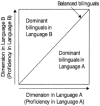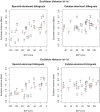Plasticity, Variability and Age in Second Language Acquisition and Bilingualism
- PMID: 29593590
- PMCID: PMC5857581
- DOI: 10.3389/fpsyg.2018.00081
Plasticity, Variability and Age in Second Language Acquisition and Bilingualism
Abstract
Much of what is known about the outcome of second language acquisition and bilingualism can be summarized in terms of inter-individual variability, plasticity and age. The present review looks at variability and plasticity with respect to their underlying sources, and at age as a modulating factor in variability and plasticity. In this context we consider critical period effects vs. bilingualism effects, early and late bilingualism, nativelike and non-nativelike L2 attainment, cognitive aging, individual differences in learning, and linguistic dominance in bilingualism. Non-uniformity is an inherent characteristic of both early and late bilingualism. This review shows how plasticity and age connect with biological and experiential sources of variability, and underscores the value of research that reveals and explains variability. In these ways the review suggests how plasticity, variability and age conspire to frame fundamental research issues in L2 acquisition and bilingualism, and provides points of reference for discussion of the present Frontiers in Psychology Research Topic.
Keywords: age factors; bilingualism; critical period; dominance; individual differences; plasticity and learning; second language acquisition; variability.
Figures







References
-
- Abrahamsson N., Hyltenstam K. (2009). Age of onset and nativelikeness in a second language: listener perception versus linguistic scrutiny. Lang. Learn. 59 249–306. 10.1111/j.1467-9922.2009.00507.x - DOI
-
- Ahn S., Chang C. B., DeKeyser R., Lee-Ellis S. (2017). Age effects in first language attrition: speech perception by Korean-English bilinguals. Lang. Learn. 67 694–733. 10.1111/lang.12252 - DOI
-
- Altman D. G. (1998). “Categorizing continuous variables,” in Encyclopedia of Biostatistics eds Armitage P., Colton T. (New York, NY: Wiley; ), 563–567.
-
- Amengual M. (2014). The perception and production of language-specific mid-vowel contrasts: shifting the focus to the bilingual individual in early language input conditions. Int. J. Biling. 20 133–152. 10.1177/1367006914544988 - DOI
Publication types
LinkOut - more resources
Full Text Sources
Other Literature Sources
Medical

